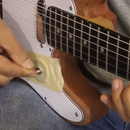Introduction: Remote Controlled Strandbeest
You've seen the kits available for around $10 or less for a Strandbeest wind walker, but what if there is no wind? In this Instructables, I go over how to easily add a pair of motors to the 'beest in order to remote control it like a tank. A full video of the build can be found here, and I'll embed it at the end for your viewing pleasure.
Step 1: Build Your Beest
The first step is to get and assemble a Strandbeest kit. If you're not in a rush, you can find them for sale for $5 or so, but I used this one from Amazon. A video of the assembly process, can be found here. Split it into two as shown so that each set of legs can steer like a tank.
Obviously having it fall onto the ground is generally discouraged but is fun to watch.
Step 2: Get Materials
Besides the aforementioned kit, you'll need the following:
- 28BYJ-48 Stepper Motor w/ ULN2003 driver [5 pack on Amazon]
- Section of perf-board
- Arduino Nano or clone [3 pack on Amazon]
- Keychain Remote [from eBay]
- Buck step down voltage converter [from Amazon, appears to be slightly different model]
- Small LiPo batteries/connector [Similar to this and this both via Amazon]
- Lots of zip ties and hot glue!
Note that Amazon links here and on the previous page are affiliate.
Step 3: Prepare Motors
Hot glue motors back-to-back. Cut and attach a plastic rod (that came with the kit in my case) across the mounting holes as shown.
Step 4: Modify Beest and Attach Motors
In order to transmit power from the motors to the Strandbeest legs, cut a notch in either side as shown with a Dremel tool. Attach the motor shaft inside with hot glue, lining up the flats as needed, then zip tie it in place to hold it more securely.
Motors are held in place with zip ties and hot glue as shown.
Step 5: Hook Up Electronics and Program
Solder components onto a small perf board as shown in these images. Hookup specific I/O and program per code available here. LiPo batteries are connected in series for around 8V of power before stepped down through voltage regulator to 5V.
Step 6: Mount Electronics
First, cover the stepper motors in duct tape so your board doesn't short out all over the place, then mount the board batteries and regulator using zip ties.
Step 7: Enjoy!
You now have a 'beest that can move forwards/backwards/left/right. You may need to experiment with the button configuration to set it up properly. Also, while this is set up for direct control, there is a lot you could do with this configuration, whether modifying the stepper speed, or having it march around in a pre-programmed path.
Step 8: Video:
And as promised, here's the video! As you may or may not know, I've built several of these devices from scratch, and you can find the whole "ClearWalker" story via this YouTube playlist. Or just check out/subscribe to my channel - I make all kinds of ridiculous things, so if you enjoyed this, it's worth poking around!

Participated in the
Microcontroller Contest








![Tim's Mechanical Spider Leg [LU9685-20CU]](https://content.instructables.com/FFB/5R4I/LVKZ6G6R/FFB5R4ILVKZ6G6R.png?auto=webp&crop=1.2%3A1&frame=1&width=306)




